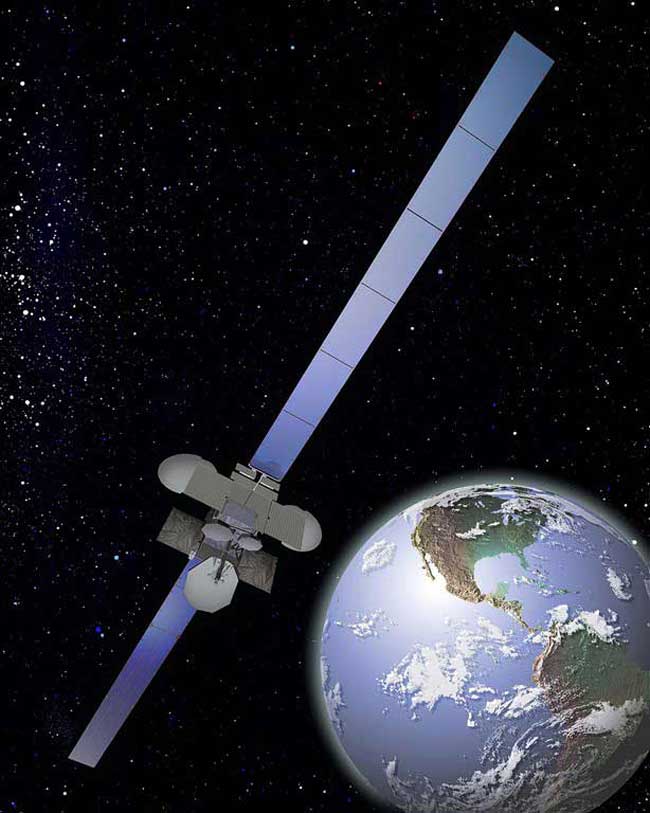Satellite Internet Is Set For a Big Leap Forward in 2012

Broadband Internet delivered via satellite stands to get a big boost in 2012 when HughesNet, one of two major providers in the United States, launches a next-generation spacecraft.
The new satellite, named Jupiter, will be able to transfer data faster than the company's current dedicated Spaceway satellite and an array of transponders leased on other orbiting craft.
Speed and subscription prices are not yet set, but even a potential download rate of 20 megabits per second (mbps) would be 10 times the current rate and should be available for comparable prices, according to statements from HughesNet,
All this would be good news for the more than 10 million Americans who lack access to high-speed Internet, which is usually defined internationally as greater than 256 kilobits per second, and defined by the U.S. Federal Communications Commission as 4 mbps download and 1 mbps upload.HughesNet is counting on finding a lucrative market for the service in homes outside metropolitan areas.
Satellite Internet fills a gap
Many of us have heard of satellite radio and satellite television, yet "satellite Internet" has not yet made it into the vernacular. Compared with those other services, satellite Internet is indeed a niche market, with only about a million subscribers and 1 percent of the broadband Internet market. By contrast, satellite TV has fully a third of the paid-TV market, with over 30 million subscribers, and satellite radio has around 20 million listeners.
Satellite Internet cannot compete with the speed of terrestrial means of broadband such as cable and DSL (digital subscriber line). Instead, HughesNet — the biggest provider of the service, with more than 550,000 subscribers — and its main competitor, WildBlue, battle it out for customers who are sick of slow dial-up connections. For many Americans in rural locations, old-school dial-up remains the only option for Internet access.
Get the world’s most fascinating discoveries delivered straight to your inbox.
Cable and telephone companies, the conventional providers of broadband, often decline to add broadband infrastructure to sparsely populated areas because it ceases to make financial sense, said Peter Gulla, a vice president in the North American division of Hughes Network Systems LLC, which is based in Germantown, Md.
Unserved or underserved regions are "where we really fit the bill," said Gulla. "These households range from very, very rural areas to areas that are underserved in the sense that they live just beyond the reach of land-based alternatives."
This situation is common just outside major metropolitan centers, since broadband landlines extend only so far. “There’s always one more house at the end of that road," Gulla said.
A technical requirement for setting up satellite Internet at one's home or business in North America is that the satellite dish for sending and receiving signals must have an unobstructed view of the southern sky. That is because the satellites are in a geostationary, or fixed-position, orbit 22,000 miles (36,000 km) over the equator. (This requirement is one more reason why satellite Internet does not lend itself to urban landscapes.)
A HughesNet satellite dish on a farmhouse. Credit: HughesNet
Inherent problems
The distance between sender and receiver antennas, a fact of life for satellite communication, remains a major issue in beaming the Internet from the heavens. Though the signal travels at the speed of light — 186,282 miles (299,792 km) per second — a round-trip still takes about 250 milliseconds, and other tiny processing delays on both ends can add up to a solid second of wait time.
This latency, as it's called, "plays real havoc with things as simple as online gaming or online stock trading," said Mike Jude, program manager for the consumer communications services group at Frost & Sullivan, a California-based consultancy.
For example, latency makes video conferencing choppy, and it breaks up the constant synchronization needed for the virtual private networks (VPN) that many companies use to give off-site employees secure access to important internal documents.
Playing a first-person shooter game, such as "Call of Duty: Black Ops," can be a bit frustrating over satellite Internet, Jude added. "For gaming, with that 250-millisecond delay, the bad guy'll shoot you 14 times before you can get off a shot," he joked.
The future of broadband
Despite the latency issue, Gulla sees significant growth potential for satellite Internet in the United States — obviously enough to justify the $115 million loan agreement with banks and satellite launch companies to finance the Jupiter spacecraft. (Satellites, once aloft, cannot undergo an upgrading of hardware — short of an astronaut mission — and software upgrades on the ground and in the sky can milk only so much more bit rate.)
HughesNet has identified as many as 14 million people who will continue to be left out in the cold when it comes to land-based broadband.
The U.S. government has made expanding broadband Internet access a priority, as demonstrated by the $58.7 million award given to HughesNet as part of the stimulus bill passed in January 2009.
"It's basically a validation that there are areas of the country where satellite is the best solution," Gulla told TechNewsDaily. "There are plenty of unserved customers still out there."
• Wireless Internet Use Soaring Thanks to Young People and Minorities • National Broadband Plan Not Ambitious Enough, Experts Say • 10 Profound Innovations Ahead




